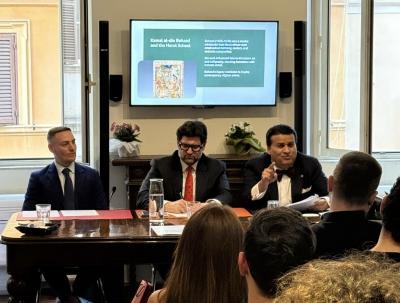EGIC conference: Through the Prism of Time: Art and the Human Experience

ROME – The Euro-Gulf Information Centre (EGIC) hosted an exclusive line up of speakers at their headquarters on Via Gregoriana as well as via zoom to discuss the topic of Art and the Human Experience.
The word of the evening was certainly ‘dreamer’ and the discussion was kickstarted by the founder of the EGIC, who in recognition of more recent trying times in the West reminded the audience that despite this more pessimistic idea that ‘culture comes from the barrel of a gun’, as was famously purported by Joseph Goebbels, culture is a reflection of art and art of culture. Thus, it transcends what we have come to think of as the human experience – it is so much more than the deathly triad of fascism, communism and liberal democracy – culture is human that is what is reflected in art all over the world.
The first speaker Dr. Mayasa al Sowaidi, Professor of Mathematics at the University of Bahrain, spoke of how art is the intersection of cultural exchange and she was delighted to be speaking at an event in Rome as there has been plenty of historic cultural exchange between Italian and Arabic culture, with pivotal moments during the renaissance. According to the doctor the geometrical patterns and calligraphy present in Arabic art is the apex of its sophistication and what sets it apart from other artforms but this could only have come about from cultural exchange circumstances in the middle-east, which is the only way that we can innovate, by interacting with new cultures and ideas.
The second speaker, the Afghani Ambassador, invigorated the room with his impassioned speech on Afghan art, telling the audience how it developed through four crucial epochs. Afghanistan, while plagued by both domestic and external existential political threats, had once been a beacon of civilisation for thousands of years.
In the Early Ariana-Zoroaster, starting from the period in which the Epic of Gilgamesh emerged from neighbouring Mesopotamia, there was already evidence of early symbolism including crucifixes, stars of David, crescent moons and swastikas. In the middle period Alexander the Great’s physical and cultural conquest bled so deeply into the region that even during the Buddhist rule that followed some statues of the Buddha were made with the face of Alexander the Great. During the late period around the sixth century and the rise of Islam depiction of people was outlawed and thus, while the west had their focus on depicting scenes from the bible and antiquity, the Arabs lent into geometric patterns and calligraphy, using semi-precious stones to create ornate designs in mosques, as opposed to gold. Lastly, in the modern period during soviet control of Afghanistan people used rug-making and embroidery as a form of expression to rebel against Russian rule in the region and now Afghani artists are able to thrive but as of right now, only in exile.
The ambassador left us with a message for aspiring artists, for he himself is a parson’s graduate, saying that art is a balance always between tradition and modernity, no matter what it represents there is always something to be learnt from it.
The final speaker Patrizio Vallena, founder of UNICO srl, spoke partially about his own craft as a jeweller but also about Italian craft and cultural attitude to art as a whole. In Italy, he said, beauty is absolutely everywhere, you do not need to seek it out for it simply is. For Italians, creation, the art of manual work is not primarily about money – it is about creating something that will last with precision and passion – something authentic. While society has been deeply impacted by cheap manufacturing and over-consumption, Italian art remains world-class as their artists are ‘dreamers’, people who make art for art’s sake and nothing else.
The founder rounded up the speeches with a few questions and his closing remarks that the difference, perhaps, between artists and us ordinary mortals is that as Oscar Wilde once said, ‘we are all in the gutter but some of us are looking at the stars.’ For the artist is able to find inspiration anywhere, in cultural-exchange, tradition and the human desire to create.
og
© COPYRIGHT ITALIAN INSIDER
UNAUTHORISED REPRODUCTION FORBIDDEN


